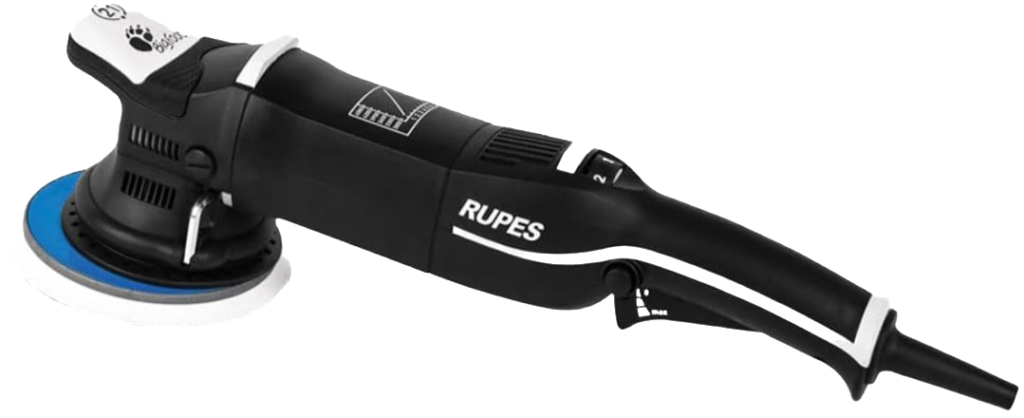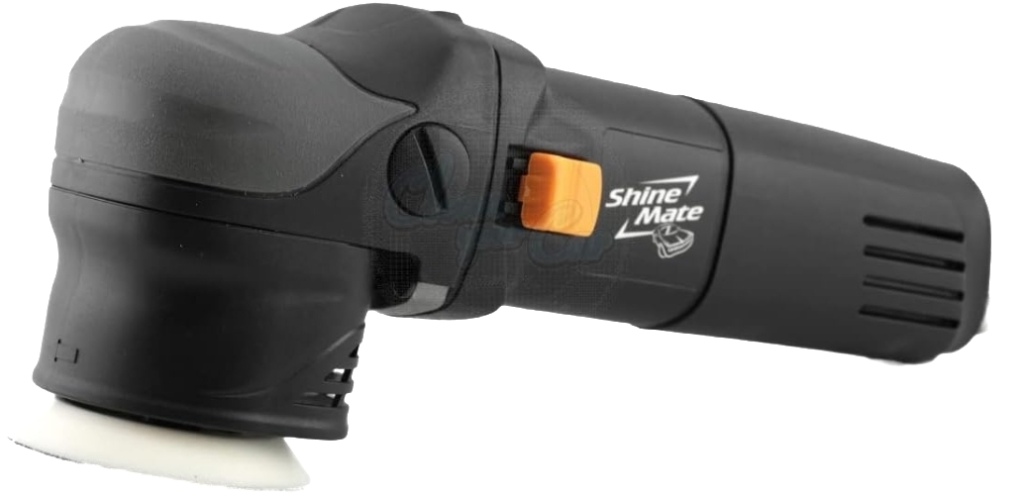CAR POLISH MACHINE
A car polish machine, also known as a car polisher or buffer, is a tool used to apply polish or wax to the surface of a car’s paintwork in order to improve its appearance. It is an essential part of the car detailing process, helping to restore and enhance the shine of the vehicle’s paint.
Table of Contents
ToggleKey features of a car polish machine include:
Electric Motor: Car polish machines are typically powered by electric motors. They come in various sizes and power ratings, with higher-powered machines being capable of more aggressive polishing.
Rotary or Orbital Action: Car polishers can have either rotary or orbital action. Rotary polishers rotate the polishing pad in a circular motion, while orbital polishers move the pad in a random or elliptical orbit. Orbital polishers are generally considered more user-friendly and are often recommended for beginners.
Variable Speed Settings: Many car polishers come with adjustable speed settings, allowing users to control the speed of the polishing action. Different speeds are suitable for various tasks, such as compounding, polishing, and waxing.
Polishing Pads: These machines use specialized foam or microfiber pads to apply polish or wax to the car’s surface. The choice of pad depends on the specific polishing or waxing task at hand.
Handle and Grip: Car polish machines typically have ergonomic handles and grips to ensure comfortable handling during use. This is important for extended polishing sessions.
Safety Features: Some polishers come with features such as overload protection or soft start to prevent damage to the paint or the machine itself.
Using a car polish machine offers several benefits:
Efficiency: Car polish machines can significantly reduce the time and effort required to polish a car compared to doing it by hand.
Consistent Results: The machine ensures a more uniform application of polish or wax, resulting in a consistent finish.
Professional-Looking Results: When used correctly, a car polish machine can produce results that rival those achieved by professional detailers.
It’s important to note that using a car polish machine requires some skill and knowledge to avoid damaging the paint. Users should follow proper techniques, use the right polishing pads and products, and start with a lower speed setting, especially if they are new to machine polishing.
Type of Car Polish Machine
There are several types of car polish machines available in the market, each designed for specific purposes. The two main categories are rotary polishers and dual-action (DA) polishers. Within these categories, there are variations in terms of size, power, and features. Here’s an overview:
Rotary Polishers:
- Description: Rotary polishers have a spinning, circular motion. They are more aggressive than dual-action polishers and are generally preferred by professionals for tasks like paint correction.
- Use Cases: Ideal for removing deep scratches, heavy oxidation, and severe paint defects.
- Pros: Effective for heavy-duty polishing tasks, faster correction of imperfections.
- Cons: Requires more skill to avoid causing damage to the paint, generates more heat.
Dual-Action (DA) Polishers:
- Description: Dual-action polishers have a combination of spinning and oscillating movements, which reduces the risk of paint damage compared to rotary polishers.
- Use Cases: Suitable for general polishing, light to moderate paint correction, and wax application.
- Pros: Safer for beginners, less risk of paint damage, versatile for various detailing tasks.
- Cons: May take longer to correct severe paint defects compared to rotary polishers.
Forced Rotation Dual-Action (DA) Polishers:
- Description: These polishers have a forced rotation mechanism that provides more cutting power compared to traditional dual-action polishers.
- Use Cases: Effective for moderate to heavy paint correction while maintaining the safety features of dual-action polishers.
- Pros: Offers more correction power than standard DA polishers without the risk of overheating paint.
- Cons: Typically heavier and more expensive than standard dual-action polishers.
Mini Polishers:
- Description: Smaller, lightweight polishers designed for precision work in tight or intricate areas where larger machines may struggle to reach.
- Use Cases: Ideal for spot correction, smaller panels, or detailed areas.
- Pros: Maneuverable in tight spaces, less fatigue during extended use on small areas.
- Cons: Not suitable for large-scale polishing tasks.
Long-Throw Polishers:
- Description: These polishers have a larger throw or orbit, meaning the pad covers a greater area with each rotation, allowing for faster correction.
- Use Cases: Effective for larger panels, reducing the time required for paint correction.
- Pros: Increased efficiency for larger surface areas, potentially reducing polishing time.
- Cons: May be heavier and more expensive than standard throw polishers.
When choosing a car polish machine, it’s essential to consider your skill level, the specific tasks you’ll be performing, and the type of paint correction required for your vehicle. Beginners often find dual-action polishers to be more forgiving, while experienced detailers may prefer the precision and power of rotary polishers for specific applications.
Type of Power Sources For Car Polishers
Car polishers are typically powered by different sources, and the choice often depends on the user’s preferences, convenience, and the specific features of the polisher. Here are the main types of power sources for car polishers:
Electric-Powered Polishers:
- Description: The majority of car polishers are electric-powered and plug into standard electrical outlets.
- Types:
- Corded Electric Polishers: Directly powered through an electrical cord connected to a power outlet. These provide consistent power but may have limited mobility due to the cord.
- Cordless Electric Polishers: Powered by rechargeable batteries, offering more flexibility and freedom of movement. However, they may have limited run time before requiring a battery recharge.
Pneumatic (Air-Powered) Polishers:
- Description: Pneumatic polishers are powered by compressed air.
- Use Cases: Common in professional settings where compressed air systems are available.
- Pros: Generally lightweight and easy to maneuver; suitable for extended use.
- Cons: Requires an air compressor, which adds to the overall equipment cost.
Battery-Powered Polishers:
- Description: Similar to cordless electric polishers, these polishers are specifically powered by rechargeable batteries.
- Use Cases: Offer the convenience of cordless operation without the need for an electrical outlet.
- Pros: Portable and convenient; no cord restrictions.
- Cons: Run time is limited by battery capacity; may need to recharge or replace batteries during extended use.
The choice of power source depends on factors such as the user’s preference, the availability of power sources, the intended use of the polisher, and the need for mobility. Corded electric polishers provide consistent power but may have limitations in terms of mobility due to the cord. Cordless electric and battery-powered polishers offer greater freedom of movement, making them suitable for tasks where mobility is crucial.
It’s essential to consider factors such as runtime, power output, and the availability of power sources when selecting a car polisher. Additionally, some users prefer the convenience of cordless options, while others prioritize the continuous power supply of corded polishers.
Here are some examples of polish machines for you. You can buy as per your need from the given link.
Dewalt DCM848P2 18V Dual Action Polisher (Battery Powered)
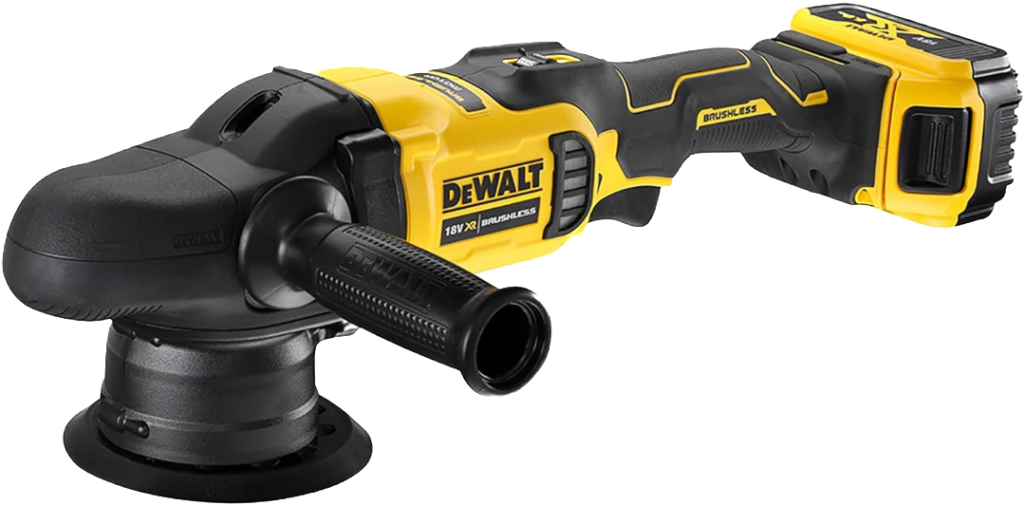
Type:
- The DEWALT DCM848P2 is likely a dual-action polisher, which means it features a combination of rotation and oscillation movements. Dual-action polishers are known for being user-friendly and safer for those who are new to machine polishing.
Power Source:
- The “18V” in the model name indicates that the polisher operates on an 18-volt battery. Cordless polishers provide greater mobility and flexibility since they are not restricted by power cords.
Power and Performance:
- Dual-action polishers are generally designed to be less aggressive than rotary polishers, making them suitable for various detailing tasks without the risk of damaging the paint.
Variable Speed Settings:
- Dual-action polishers often feature variable speed settings, allowing users to adjust the speed based on the specific task at hand. This flexibility is beneficial for different stages of polishing or when working on various surfaces.
Ergonomics:
- DEWALT tools are known for their ergonomic designs, and the DCM848P2 is likely to have a comfortable grip and well-balanced construction to minimize user fatigue during extended use.
Applications:
- Dual-action polishers are versatile and can be used for tasks such as paint correction, removing swirl marks, polishing, and applying wax or sealants.
Battery and Charger:
- Cordless polishers usually come with rechargeable batteries and a charger. The runtime and charging time will depend on the specific battery capacity and charger provided.
Accessories:
- The polisher may come with compatible backing plates and polishing pads. The choice of accessories can impact the effectiveness of the polisher for different tasks.
To get specific details about the DEWALT DCM848P2 18V Dual Action Polisher, We recommend checking the manufacturer’s website, product manuals, or contacting the manufacturer directly for the most up-to-date and accurate information. User reviews can also provide insights into real-world performance and reliability.
Type:
- The Rupes LHR21 III is a random orbital polisher, featuring a dual-action motion. Random orbital polishers are known for their versatility and safety, making them suitable for both professionals and enthusiasts.
Power and Performance:
- The polisher is equipped with a powerful motor to deliver effective paint correction and polishing results.
- It typically features variable speed settings, allowing users to customize the tool’s performance based on the specific task at hand.
Orbit Size:
- The “21” in the model name refers to the diameter of the orbit, measured in millimeters. In this case, the tool has a 21mm orbit, providing a larger throw than some other random orbital polishers. A larger throw can cover more surface area per pass, potentially speeding up the polishing process.
Ergonomics:
- Rupes pays attention to ergonomics in its tool design, and the LHR21 III is likely to have a comfortable grip and well-balanced construction to minimize user fatigue during extended use.
Build Quality:
- Rupes tools are known for their robust build quality. The LHR21 III is expected to be durable and capable of withstanding the demands of professional detailing.
Applications:
- Random orbital polishers are versatile and can be used for various detailing tasks, including paint correction, removing swirl marks, and applying wax or sealants.
Safety Features:
- The polisher may include safety features such as electronic speed control and overload protection to ensure safe and controlled operation.
Accessories:
- Rupes often provides a range of accessories, including backing plates and polishing pads, designed to work seamlessly with their polishers. These accessories are essential for achieving optimal results in different detailing applications.
Please note that details about specific products, including the Rupes LHR21 III, can change over time. It’s advisable to check the latest product specifications, user reviews, and any updates from the manufacturer for the most accurate and current information before making a purchase.
DEWALT Polisher DWP849X Variable Speed Polishers with Soft Start
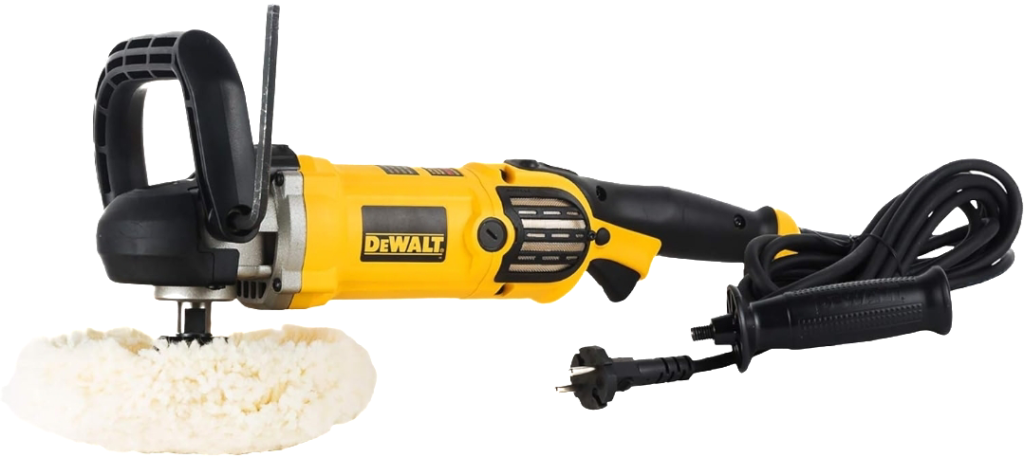
Type:
- The DEWALT DWP849X is a rotary polisher, which means it has a spinning, circular motion. Rotary polishers are often chosen for their effectiveness in heavy paint correction tasks.
Power and Performance:
- The polisher is equipped with a powerful motor to provide ample torque for various polishing tasks.
- It features variable speed control, allowing users to adjust the speed based on the specific requirements of the job. This is particularly useful for tasks that may vary in intensity, such as paint correction.
Build and Design:
- DEWALT tools are known for their robust build and durability, and the DWP849X is no exception.
- The tool is designed for professional use, and it typically features a sturdy construction to withstand the demands of heavy-duty polishing.
Handle and Ergonomics:
- The DEWALT DWP849X is designed with user comfort in mind, featuring an ergonomic design to reduce fatigue during extended use.
- The handle is likely to be well-designed for a comfortable and secure grip, providing the user with precise control over the tool.
Safety Features:
- DEWALT tools often come with safety features, and the DWP849X may include features such as electronic speed control and overload protection to enhance user safety.
Applications:
- Rotary polishers like the DWP849X are versatile and can be used for a range of applications, including paint correction, removing swirl marks, and polishing automotive surfaces to a high gloss.
Accessories:
- The DEWALT DWP849X may come with various accessories, such as backing plates and polishing pads, or they may be available separately. These accessories are crucial for achieving optimal results in different polishing tasks.
Keep in mind that product specifications and features may be subject to updates or changes, so it’s recommended to check the latest information, user reviews, and any product improvements or revisions that may have occurred since my last update. Always follow the manufacturer’s guidelines and safety instructions when using power tools like the DEWALT DWP849X.
Type:
- The Shine Mate Dual Action Orbital Polisher is likely a dual-action polisher, meaning it combines both rotation and oscillation movements. This type of polisher is known for being user-friendly and safer for those who are new to machine polishing.
Power and Performance:
- Dual-action polishers are designed to be less aggressive than rotary polishers, making them suitable for various detailing tasks without the risk of damaging the paint.
Variable Speed Settings:
- Dual-action polishers typically feature variable speed settings, allowing users to adjust the speed based on the task at hand. This can be beneficial for different stages of polishing or when working on different surfaces.
Ergonomics:
- Dual-action polishers often prioritize ergonomic design to provide a comfortable grip and reduce user fatigue during extended use.
Orbit Size:
- The “5/12” in the model name may refer to the orbit size, measured in millimeters. A larger orbit size can cover more surface area, potentially speeding up the polishing process.
Applications:
- Dual-action orbital polishers are versatile and can be used for tasks such as paint correction, removing swirl marks, polishing, and applying wax or sealants.
Safety Features:
- Dual-action polishers typically have safety features to prevent damage to the paint, such as a random orbital motion that reduces the risk of creating holograms or buffer trails.
Accessories:
- Dual-action polishers often come with compatible backing plates and polishing pads. The choice of accessories can impact the effectiveness of the polisher for different tasks.
To get specific details about the Shine Mate Dual Action Orbital Polisher EX605/5/12, I recommend checking the manufacturer’s website, product manuals, or contacting the manufacturer directly for the most up-to-date and accurate information.
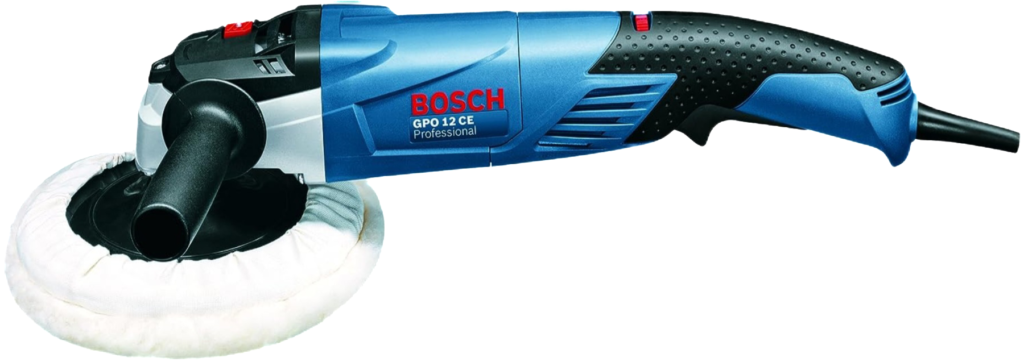
Type: The Bosch GPO 12 CE is a rotary polisher. Rotary polishers have a spinning, circular motion and are often chosen for their ability to remove deep scratches and perform heavy paint correction.
Power and Performance:
- The polisher is equipped with a powerful motor to provide the necessary torque for polishing tasks.
- It typically features variable speed control, allowing users to adjust the speed based on the specific requirements of the job.
Build and Design:
- The Bosch GPO 12 CE is designed for professional use, and it often features a robust build for durability.
- It may have additional features such as a soft start to prevent product flinging at the beginning of the polishing process.
Handle and Ergonomics:
- Professional polishers often prioritize ergonomics to reduce user fatigue during extended use.
- The handle design is likely to be comfortable and provide a secure grip for precise control.
Safety Features:
- Bosch tools typically include safety features to protect both the user and the machine. This may include features such as overload protection.
Applications:
- Rotary polishers like the Bosch GPO 12 CE are commonly used for heavy-duty tasks such as paint correction, removing swirl marks, and restoring the finish on automotive surfaces.
Before purchasing the Bosch GPO 12 CE or any power tool, it’s recommended to check the most recent product specifications, user reviews, and any updates to the model that may have occurred since my last update. Always follow the manufacturer’s instructions for proper use and maintenance of the tool.
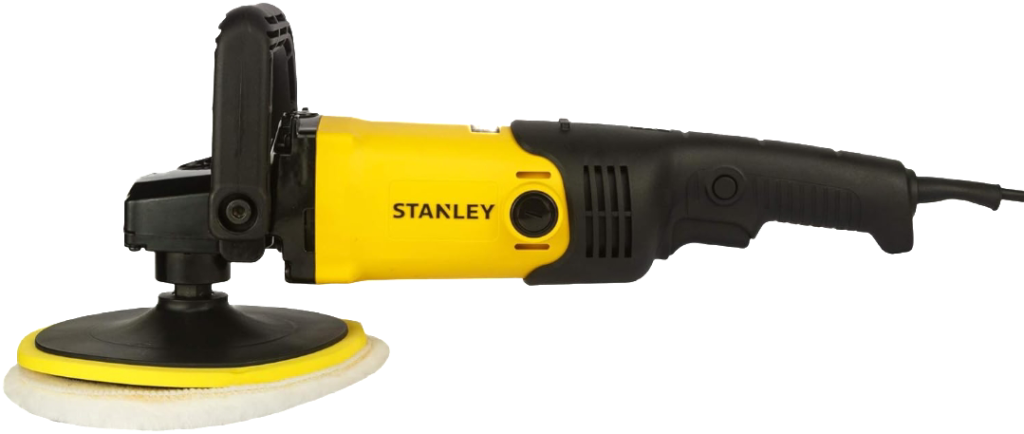
Type:
- The STANLEY SP137-IN is likely a rotary polisher since it has a power rating specified (1300W). Rotary polishers are known for their circular, spinning motion and are often used for more aggressive paint correction tasks.
Power and Performance:
- The 1300W power rating suggests a relatively powerful motor, suitable for tasks such as heavy paint correction or polishing.
Variable Speed Settings:
- Many rotary polishers, including higher-end models, offer variable speed settings. This feature allows users to adjust the speed of the polisher to suit different tasks and surface conditions.
Handle and Ergonomics:
- Good rotary polishers often have ergonomic designs to provide a comfortable grip and reduce user fatigue during extended use.
Safety Features:
- Rotary polishers may include safety features such as soft start, which prevents the machine from jerking when it starts, and overload protection to prevent damage to the motor.
Applications:
- Rotary polishers like the STANLEY SP137-IN are commonly used for tasks like paint correction, removing deep scratches, and aggressive polishing. They are powerful tools suitable for professional detailing.
Accessories:
- The polisher may come with accessories like backing plates and polishing pads. The choice of accessories can impact the effectiveness of the polisher for different tasks.
To get specific details about the STANLEY SP137-IN 1300W polisher, I recommend checking the manufacturer’s website, product manuals, or contacting the manufacturer directly for the most up-to-date and accurate information. Additionally, user reviews can provide insights into the real-world performance and reliability of the tool.
Certainly! Let’s explore the positive and negative aspects of using a polishing machine:
Positive Side:
Efficiency: Polishing machines, especially power tools, are generally more efficient than manual methods. They can cover larger areas and complete tasks more quickly.
Consistent Results: Polishing machines provide a consistent application of polish or wax, resulting in a uniform finish. This is often challenging to achieve with manual methods.
Time-Saving: Using a polishing machine can significantly reduce the time and effort required for detailing tasks, especially for larger surfaces like car exteriors.
Professional-Looking Finish: When used correctly, polishing machines can produce a high-quality, professional-looking finish that rivals the results achieved by automotive detailing professionals.
Versatility: Polishing machines come with variable speed settings and different polishing pads, making them versatile for various tasks such as paint correction, polishing, and waxing.
Negative Side:
Skill Requirement: Proper usage of a polishing machine requires some skill and knowledge. Beginners may need to practice to avoid causing damage to the vehicle’s paint.
Cost: Quality polishing machines can be relatively expensive, especially those designed for professional use. Additionally, there may be ongoing costs for accessories and maintenance.
Potential for Damage: Incorrect use of a polishing machine, especially high-powered rotary polishers, can lead to paint damage such as swirl marks or burns if not used carefully.
Noise and Vibration: Some polishing machines can be noisy, and the vibration during operation may lead to user fatigue, especially during extended use.
Cord Restrictions: Corded polishing machines may have limitations in terms of mobility due to the cord length. Cordless options mitigate this issue but may have limitations related to battery life.
In summary, while polishing machines offer significant advantages in terms of efficiency and achieving professional results, users should be aware of the potential learning curve, associated costs, and the need for careful operation to avoid damage. Proper technique, knowledge of the machine’s features, and adherence to safety guidelines are crucial for maximizing the benefits of polishing machines.

